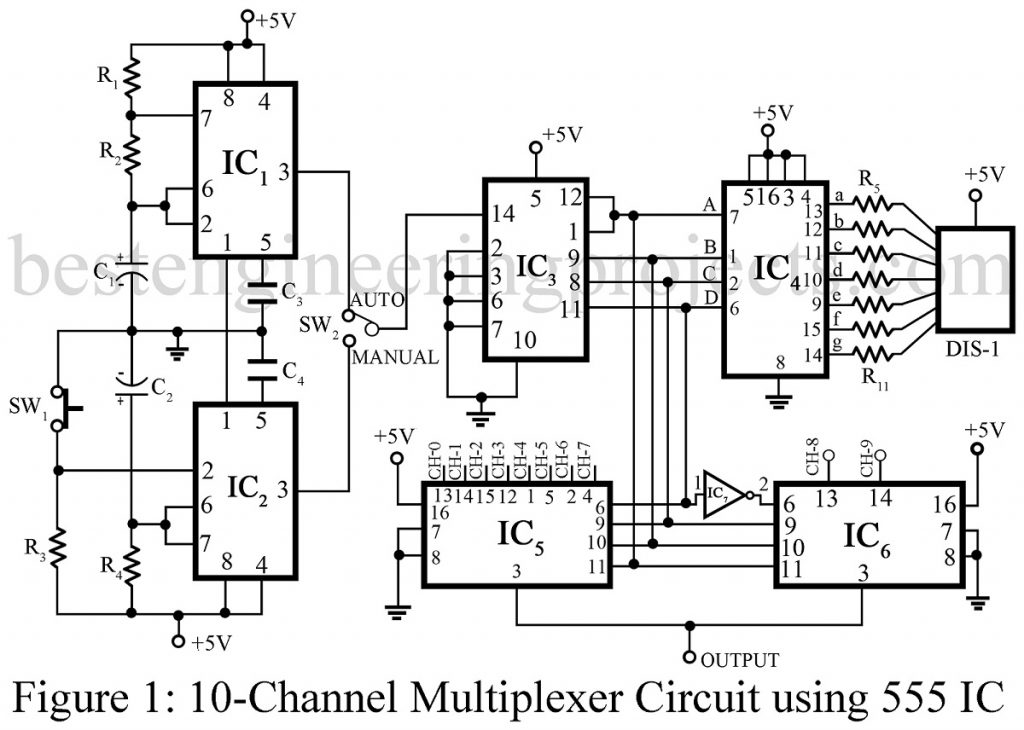This project is a low-cost multiplexing system for ten channels. The project 10-channel multiplexer circuit using 555 IC can be used as an add-on device for a single point indicating system. Both auto and manual selection are incorporated with the visual indication of channel number. It is suitable for signals concerning a common line.
However, for double-ended signals, the input LOW lines can be made common and the input High lines can be multiplexed. This can be used for thermocouple signals, strain gauges, and any other AC/DC signal in the range of 0 to 5 volts.
Circuits Diagram of 10-channel Multiplexer Circuit using 555 IC
The hearts of the multiplexing system are CMOS IC TC4051, 8:1-channel high-performance analog multiplexer/de-multiplexer. Two such chips are used to accommodate ten channels. An IC555 (IC1) is used to generate a pulse for the counter clock in the automating mode of operation. Another IC 555 (IC2) is triggered with each push of a manual channel advance button. These form very low-cost debounce and clock circuits.
A toggle switch is used to select the auto or manual mode of operation. No debounce is given for this switch. A decade counter is used for addressing channels and the count is given to a BCD-to-7-segment decoder-divider which subsequently drives the display chip. The counter is also used for selecting a channel by feeding it to the address pins of the multiplexer.
Power Supply | 10-Channel Multiplexer Circuit using 555 IC
A 5V power supply is used to drive the ICs. It is implemented by a step-down transformer, bridge rectifier, and 5V regulator.
The circuit can also be adapted for a 3V to 9V battery-operated version. In that case, all the 74 series ICs have to be replaced by CMOS/MOS ICs. Also, the circuit can be modified for negative signals by connecting -5V to the VEE supply pin of TC4051. The circuit can be fabricated on a general-purpose PCB.
The clock for the auto operation was chosen to be 8 seconds. This is sufficient time for any pen-type recorder to balance and record the reading. The debounce moonshot pulse width is 0.5 seconds, which is enough to ensure debounce for any low-cost pushbutton switch.
The circuit was tested with mV input and the output was found to follow the input. The load condition under test was of the order of 10K. The clock time may be quite high for some applications, but it can be decreased by reducing the value of the capacitor used in the clock circuit.
Check out more interesting 555 Timer IC Projects posted on bestengineeringprojects.com
- Motor Controller Circuit for Washing Machine
- Automobile Brake Failure Indicator
- CCTV Switcher Circuit using Timer IC 555
- Phase Sequence Change Indicator
- Wireless Mobile Charger Circuit Diagram
PARTS LIST OF 10-CHANNEL MULTIPLEXER CIRCUIT USING 555 IC
| Resistor (all ¼-watt, ± 5% Carbon) |
| R1 = 22 KΩ
R2 = 33 KΩ R3, R4 = 5.6 KΩ R5 – R11 = 330Ω |
| Capacitors |
| C1 = 125 µF/10V (Electrolytic capacitor)
C2 = 100 µF/10V (Electrolytic capacitor) C3, C4 = 0.1 µF (Ceramic Disc) |
| Semiconductors |
| IC1, IC2 = NE555 (Timer IC)
IC3 = 7490 (decade counter) IC4 = 7447 (BCD to 7-Segment Decoders/Drivers) IC5, IC6 = 4051 (8 channel analog multiplexer/demultiplexer) IC7 = 7404 (Hex Inverter) |
| Miscellaneous |
| SW1 = Push-to-on Switch
SW2 = Two-way switch DIS1 = LTS542 |
